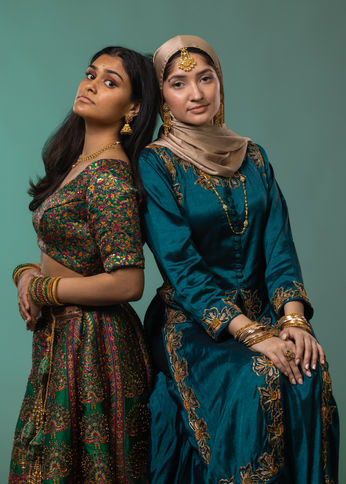Asian Pacific American Heritage Month
Photos by Maddison Hill of Mahum Hakin & Shreya Abraham
By Maddison Hill
Colors, textures, dazzling jewelry, and beau-tifully intricate designs shape the fashion landscape of Hindu culture. Here, fashion emerges as a living, breathing narrative of tradition and innovation. In Hindu culture, fashion is more than a means of adornment. Fashion is a celebration of culture, identity, and art passed down through generations.
From the ancient threads of Banarasi Silk Saris to the delicate shimmer of Kundan Jewelry, every garment and accessory reveals tales of history, craftsmanship, and timeless elegance.
Banarasi Silk
Sari At the heart of Hindu fashion lies the Banarasi Silk Sari. The Sari originated in the ancient city of Vara-nasi during the Mughal Era. Saris are a long singular piece of fabric ranging between 4 and 9 yards. The Sari, intricately threaded by Gujarati silk weavers, highlights beautiful folds and pleats, all handmade.
Haath Phool
Exquisite accessories are a key element in Hindu fashion. Accessories add an extra layer of charm to Hindu fashion. The Haath Phool, translating to “flower of the hand,” is a jewelry piece originating from Persia. The Haath Phool is an elegant hand-piece, featuring a wrist bracelet connected to a me-dallion. The medallion connects to five rings on the fingers. Traditionally, the Haath Phool is with mirror work. Mirror work on the Haath Phool allows women, and traditionally Mughal Queens, to view their reflection through-out the day.
Maang Tikka
The Maang Tikka is another stunning Hindu accessory. Maang Tikkas are positioned in the middle of the forehead. Maang Tikka translates to “middle parting ornament,” maang meaning middle part and tikka meaning ornament. Positioned in the center of the forehead, the Maang Tikka is a medallion connected to a chain. The Maang Tikka holds an abundance of meaning in Hindu culture.
Lehengas
Lehenga’s hold centuries of tradition, pre-dating the Mughal Empire. Lehenga’s consists of three pieces: a Choli (blouse), a Le-hengah (skirt), and a Dupatta (scarf ). The intricacy of a Lehengah depends on the occasion, as they can be simple or elaborate.
Anarkali Lehenga
In a more modest style, Anarkali Lehengas blends Anarkali dresses and Lehengas. The Anarkali Lehenga is made of a skirt worn be-neath a long kurta. Anarkali means the “flower of a pomegranate” and originates from a centuries-old story about an enslaved girl in Lahore during Emperor Akbar’s rule.
Choora, Jhumka, and Nathani
South Indian and Hindu fashion have an abundance of stunning accessories. Each accessory has its own unique history and cultural significance.
Traditional Choora are bangles with centuries-old significance in South Asian traditions. Choora comes in many styles and is worn by anyone. However, bridal Choora is more significant to Punjabi and northern Indian cultures.
Jhumka earrings are bell shaped earrings that date back to the Chola Dynasty. The term “Jhumka” refers to the sound of a jingling bell.
The Nathani is a circular nose ring with a long history in South Asia. Nathani has been a symbol of womanhood since the days of the Mughal Empire. Particularly prevalent in the Gujarati region, Nathani signifies beauty, strength, and resilience.
Kundan Jewelry
Kundan jewelry, whose origins can be traced back 2500 years, is mirror work jewelry. Kundan jewelry is made from 24k gold and includes necklaces, earrings, tikkas, and rings.
Bindi
The Bindi, meaning “drop,” holds centuries of tradition and Hindu significance. Worn across South Asia with names like teep and Kumkum, it symbolizes marital status, spiritual awakening, and cultural identity. Although the Bindi has strong ties to Hinduism, it’s not strictly a Hindu tradition, and many South Asian cultures wear them.





